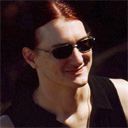Archived Entries for January, 2005
January 28, 2005
Four hours at the piano, four pages of music; not a bad evening in terms of productivity, I think. I knew I wanted to work on composing some music, but I didn't have any particular inspiration to work from, so I decided to just write down that Handel-inspired D-minor theme that's been looping its determined way through my brain for the last month and a half and see what came of it. The theme inspired a variation, an arpeggiated piano solo, a chord-change to a whole new section with a really heavy bass line... the lyrics remain stubbornly blank, but I'm happy with the way it's coming together.
January 25, 2005
I spent some time working on the “magnetic poetry via Markov chains” project this evening. It was more of an experimental foray than an actual implementation session; I wanted to play with the algorithms and see how they worked in real life. It was fun and interesting; I'm pretty sure the project is going to work, though a few design changes will be necessary.
I started with a third-order word-based Markov chain and the complete sonnets of William Shakespeare. As a producer of Shakespeare-style text, this worked extremely well - so well, in fact, that it was difficult to come up with any phrases that had not already appeared somewhere in the original. Most two-word prefixes had only a single following option, and one could run through entire sentences straight out of the original text without ever having the option to take another path. This is interesting, but not at all the party game I was looking for.
My first guess was that the body of input text simply wasn't large enough; that words were not repeated enough times in the course of Shakespeare's sonnets to give a full sense of their applicable contexts. So I went back to Project Gutenberg and picked up the complete works of Shakespeare, some 5.3 MB of text, and tried the whole thing again. After many minutes of data crunching, I discovered that the same pattern held: most pairs of words have only a single trailing option.
Now, I'm sure there are all kinds of interesting conclusions one can draw from this data, but I'm not a linguist, so I can only say “hmm, that's interesting” and get on with the business of writing my computer game. Next attempt: dumb the algorithm down and use a second-order chain instead. This way the predictor only looks at the immediately preceding word, instead of the two preceding words. This works out a lot better, but there are still a surprising number of words that are only followed by a single other word.
At this point I had to give up for the night, but I have an idea for the next step. I'll make the analyzer spot these one-option chains and merge them together. The player would still have the option of selecting a word that had only one possible following word, but the list would show both the word and its follower, so the player would pick a two-word combination at once. I don't want the player to get into a state where they have to click "ok, ok, ok" because there is only one option for a word to play. They should have a choice to make at every turn, and I don't think anyone will mind that the list of choices contains entire phrases instead of just single words.
It's kind of like playing dominoes, with words instead of numbers.
January 24, 2005
A review of Malcom Gladwell's new book “Blink” eventually forwarded me over to an article of his from a few years back called “The Naked Face”. I'd read it before, but one section jumped out at me this time, explaining why I used to find the notion of “body language” so distasteful:
[sociologist Erving] Goffman said that part of what it means to be civilized is not to “steal” information that is not freely given to us. When someone picks his nose or cleans his ears, out of unthinking habit, we look away. [...] For Goffman the spoken word is “the acknowledged information, the information for which the person who states it is willing to take responsibility,” and he goes on:
When the secretary who is miserable about a fight with her husband the previous night answers, “Just fine,” when her boss asks, “How are you this morning?” - that false message may be the one relevant to the boss's interactions with her. It tells him that she is going to do her job. The true message - that she is miserable - he may not care to know about at all as long as she does not intend to let it impair her job performance.
What would the boss gain by reading the subtle and contradictory microexpressions on his secretary's face? It would be an invasion of her privacy and an act of disrespect. More than that, it would entail an obligation. He would be obliged to do something, or say something, or feel something that might otherwise be avoided entirely. To see what is intended to be hidden, or, at least, what is usually missed, opens up a world of uncomfortable possibilities. This is the hard part of being a face reader.
January 22, 2005
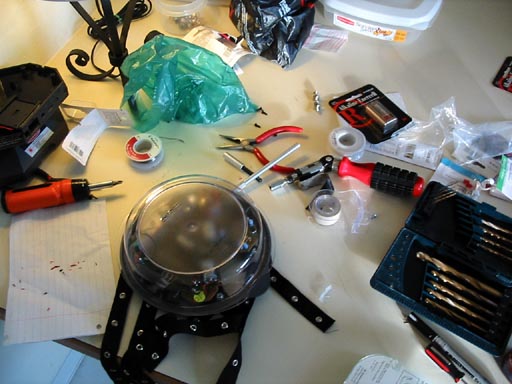
LAVI-zero, take two, with a new translucent housing
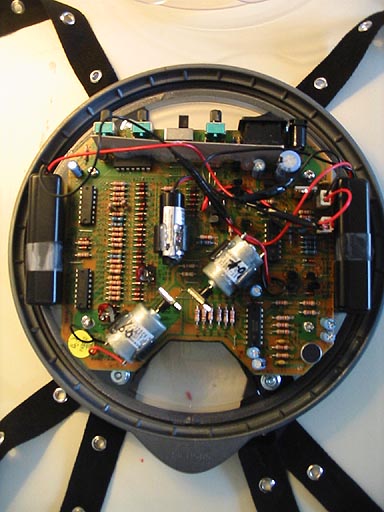
It's the same circuitry, but now it has its own backpack straps
instead of being part of my Burning Man vest.
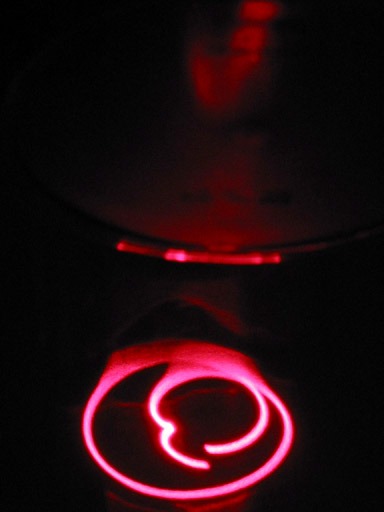
Some of the laser light reflects back from the inside of the plastic
shell, giving the device a flickering internal glow.
Now this is the laser control circuit I have been looking for! 64 elements, cascadable, controlled by serial, and each dot is individually addressable. And they only cost $34 each.
In other laser-related news, I'm reworking LAVI-zero in preparation for tonight's Techgnosis party and the Infected Mushroom concert, both of which call for wearable flashy blinky electronic things (albeit for slightly different reasons). I decided that having it integrated into a piece of clothing, while interesting, isn't as versatile as I would like. Beyond that, people at Seacompression had a hard time figuring out where the light on the ground was coming from; this time I'm mounting it in a transparent housing, so you can see the circuit board and the laser reflector system on my back more clearly. I'm using a funky little round plastic box and some webbing straps; if I have time I may end up mounting some LEDs behind the circuit board to give the whole thing a bit of a backlit glow. That might be overkill, though; we'll see.
January 21, 2005
I was up late, I'm tired, and I'm looking ahead to about ten more hours of work today; but it's a bright clear morning teetering on the edge of spring, there's a Palestrina mass filling my room, and I feel good.
January 19, 2005
Tonight was another practice session with Caroline and Sadie. We tackled the Bach chorale from last week again, and while we haven't quite nailed it yet we did get much closer. The harmony is strange, powerful and a bit remote; definitely something designed to inspire feelings of reverence.
And then - oh, the thrill - we dug into one of my own pieces, a song with tenor melody, soprano harmony over the chorus, and a big soaring coda with independent voices. I wrote it down in a blaze of excitement after our last session and have been impatient to hear it all week. It's one thing to play the parts on the piano, and something else again to actually hear the harmony in real life; I felt almost giddy listening to it all mesh together.
Big problems with my wireless connection this week, so I haven't had many opportunities for updates. Just installed a new Airport card, which doesn't seem to have completely solved the problem... it'll get worked out eventually, but it's pretty frustrating in the meantime.
New York Photos Up At Last!
Yes, that's right - almost a year after everyone but me has ceased caring, I have finally finished putting together a web site with the photos from my trip to New York last May.
This was probably the last photo gallery I will ever construct in the classic individually-coded style. The web isn't really a creative medium for me anymore, and as this experience proves, if I don't get the pictures up right away I may never get them uploaded at all, barring some unusual degree of determination. So, from now on, I'm just going to do it the way I did for my Burning Man photos this year: throw 'em all at Photoshop and let it sort the details out.
For what it's worth, I did manage to suppress the urge to write a brand new RSS reader. (Today I'm trying to keep myself from writing a new email client.)
January 12, 2005
Another musical evening with Caroline and Sadie: we spent a couple of hours on Bach's “Ach Gott, vom Himmel sieh darein” from Cantata 153. It was a challenging first project - the parts are each within our individual abilities, but the piece as a whole has some unusual harmonies and tricky rhythms. I think we did pretty well, considering that none of us were familiar with the piece and we're still getting used to singing together. I was so focused on getting my part right that I scarcely had time to notice the full effect, but every now and then I'd catch a glimpse of the whole sound we were reaching for. Oh, yes.
January 11, 2005
There's nothing like going to sleep after reading about explorers on the 1911 Scott expedition freezing and dying in Antarctica, describing the warm days when the temperature got up to zero, to give you a sense of perspective about Seattle's oh-so-frigid nighttime temperatures in the mid-twenties.
January 9, 2005
First snow of the season
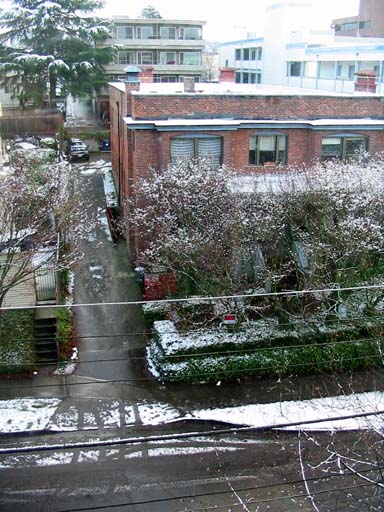
January 8, 2005
Some LED-oriented electronic kits, including a couple varieties of VU meters. I particularly like the four-dollar, six-level kit that needs no external power; that has possibilities. The dual stereo VU meter a little further down the page is more complex, but drives 20 LEDs.
Did some experiments with lasers, speakers, and sheets of mylar for the LAVI-1 project today. I discovered a few interesting things, chief among them the fact that moving lasers bounced off aluminized mylar look really cool. The mylar is always a little bit uneven, so the beams distort and flare; the reflected pattern is a semi-regular chaoticized version of the original. When the mylar is stretched across the mouth of a speaker, so the changes in air pressure cause it to bulge and subside in time with the music, the effect is just what I had hoped for. Unfortunately the space blanket material I used does not reflect quite as much visible light as I had hoped; the reflection is visibly dimmed, and is hard to see at all during daylight. I'm not sure yet whether this matters; the plan is to reflect dozens of lasers off the surface, at night, with a fog machine to hilight the beams, so it might not matter too much if some of the laser light is wasted making the speaker glow.
There were some technical problems getting the speaker to vibrate the mylar; the 8" woofer I'm using for these experiments doesn't seem to travel as far as I had expected. The mylar vibrates alright, but the heavy bass pulse I had hoped for was barely observable. I had problems getting the mylar tension as high as I wanted; I am going to try a crochet hoop and see if that helps.
Poking around in the speaker guts did trigger another idea, for LAVI-2: instead of building some bandpass filters from scratch, why not just yank the crossovers out of a pair of stereo speakers? Two stereo channels times three (tweeters/mids/woofers) gives six semi-independent signals; use each one to drive a 10-segment VU meter circuit, replace each LED with a laser, and you have an audio-reactive 60-laser controller. I'll have to find out whether speaker crossovers work at line level.
So, what's inside one of those cheap laser pointers, anyway?

The keychain assembly is attached to a cheap screw-in plastic plug; remove it and out fall three AG-13 button batteries. The gold tip has no actual function, though it can be replaced with a tip containing a filter that makes the laser project an image instead of a simple dot.

Tightly wedged inside the outer casing sits the actual laser assembly, that grey piece in the center of the picture. Its spring contacts the battery's negative pole; the circuit is completed through the metal tube that forms the body of the pointer.

January 7, 2005
Idea for this year's Skybeam: use sheets of colored plexiglas instead of spotlight gels. I can cut a circle of plexiglas to fit the mouth of the reflector dish, then cut a hole in the plexiglas and mount the spotlight bulb in it, facing down. This should get the focus effect I was hoping for, but the plexiglas sheet would be a little bit farther out of the reflector's focal plane, and much sturdier.
Looks like the Alcan 5000 is going to be held again in 2006. Maybe I'll enter that race, as my wild summer adventure next year, instead of Burning Man. (though - wow - can you imagine what a summer it would be if I tried to do both...?)
January 6, 2005
I decided to kill a little time this evening by hacking up some PHP code to extract an RSS feed from this site, so that those of you who use LiveJournal can just stick the feed on your friends lists and not have to come over here and read my entries separately. I wanted some way to test my work, so I went looking for an RSS client, which RSS people call an “aggregator”. Rather to my surprise, as far as I can tell there is not one RSS aggregator that is a) free, b) Mac-compatible, and c) actually works (i.e. not written in Java or Perl). Not a single one.
The devil on one of my shoulders says: “dude, just write one! it can't be that hard, and then you can give it away for free and irritate all the people who are trying to extort money out of all the poor non-programmers who don't know how simple apps like this really are.” The angel on the other shoulder replies: “whoa, not so fast, you've got plenty of other things going on right now! You don't need to go write a whole new app when plenty of perfectly workable examples already exist; just go download some shareware aggregator that does what you want and crack its registration scheme.” Er, wait. Maybe I got the angel and the devil mixed up. I'm not entirely sure.
Miniature scrolling LED message sign in the form of a magnet. 7x21 =147 pixels, which is fairly respectable, and very cheap at $40. This might make a good laser matrix controller, but I can also imagine a number of ways to incorporate it into an art project as-is. This vendor also carries a $40 mini fog machine; it still eats 450 watts, but that plus an average 200 watt sound system might still be doable with a cheap generator, especially if all the lighting is LED and EL-wire based. Then again all that low-power lighting would be pretty expensive anyway, so maybe I should just buy a couple of Optimas and stop worrying about power consumption so much. 55 amp-hours is a lot of juice...
A non-electric alternative to the fog machine might be a propane bug fogger. This was Phil Teller's idea; he has one loaded up with fog solution, and he says it works pretty well, though you have to keep adjusting it to keep the fog juice at the right temperature. Seems like it shouldn't be hard to rig up a simple thermistor-and-solenoid thermostat, though...
January 5, 2005
Caroline brought her friend Sadie over tonight for a couple hours of music; we swapped demos, talked about our musical interests and experience, and tried a little singing. It was pretty rough, of course, but there were a few moments when the harmony gelled, all three voices hit it at once, and the sound just tingled up the back of my neck. This could really work. We're going to try some classical trios next - maybe some Bach chorales or something - and see where it goes. I have my hopes...
January 4, 2005
Wouldn't a bubble machine be a hoot at Burning Man?
January 3, 2005
Sun, rain, snow, hail, wind; city, mountains, farmland, suburbs, wilderness. Twelve hundred miles of driving in the last two days took me through just about everything the western edge of the U.S. has to offer. It wasn't actually too hard; I didn't particularly hurry at gas stops and rest breaks, and felt that I could have gone on for another couple of hours each day without trouble. Even the long, flat run up the California Central Valley didn't bore me too much; I had good music all the way, and stopped to talk to my brother at his (very quiet) valet booth in Old Sacramento for almost an hour, so the monotony never built up too strongly.
My original plan for Sunday had been Pasadena to Redding, but after dinner at the Black Bear Diner there I still felt energetic and decided to press on. The weather changed dramatically as soon as I left the valley, though, and after noting the sudden appearance of fog, slick patches on the road, and three-foot snowbanks on either side, I decided that this was not a good time to be careening around curves after a long day in the driver's seat. I pulled off in Dunsmuir, found a motel, and called it a night.
Monday morning I woke up to the best scenery of the entire trip. The sky was bright and clear, the roads were recently plowed, and Mt. Shasta was coated with snow; the locals said it was the first clear day since Christmas. It was the classic mountain “winter wonderland”, and I enjoyed every 55-mph minute of it. If I'd pressed on to Weed, as I had hoped to do when leaving Redding, I'd have missed almost all of it.

Mt. Shasta - much snowier than last week

I pulled over on the snow-covered I-5 shoulder to take this shot; the
highway patrol rolled up and told me to get moving just as I snapped the
shutter.

Frozen ponds in the State of
Jefferson

Shasta again, from the viewpoint at the base of the climb to Siskiyou
Summit

Mt. Hood

Bridge over the Columbia - welcome back to Washington
January 2, 2005

Cold cold cold! This pass was snowed shut the next day.

January 1, 2005
Pasadena Rose Parade

Marching band from Costa Rica

The Caltech/JPL float was a giant transformer robot made of space
exploration vehicles


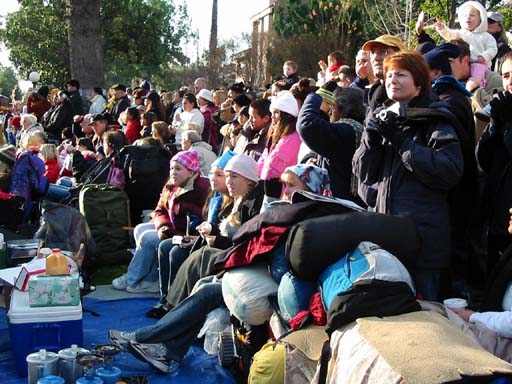


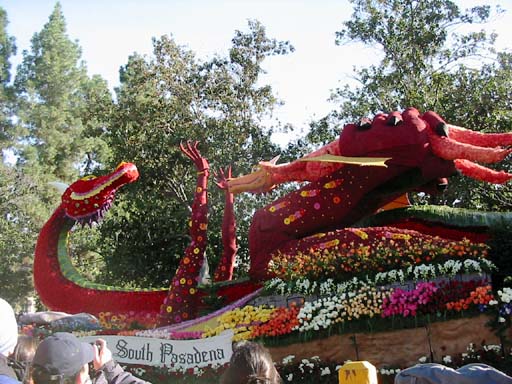
Some of my family helped decorate this one



Two and a half million people lined the five-mile route



Hiking in Griffith Park



Timothy plays “guess who” with Joanna
Santa Monica

Abigail



Cirque du Soleil's
“Cavalia” tent

Julia admires a scarf on Santa Monica Pier with Joanna and Melinda
Kramp
